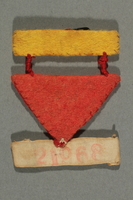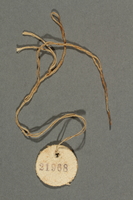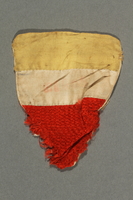Overview
- Brief Narrative
- Black plastic Star of David badge worn by Lotte Zagorska (later Charlotte Pogel) while interned in Wolta-Gabersdorf forced labor camp in Libeč, Czechoslovakia, from May 1942 to May 1945. The camp was attached to a cotton mill, and Lotte made the badge from the laborers’ work aprons. Lotte’s family was originally from Breslau, Germany, but had been forced to relocate to Katowice, Poland, in October 1938, following “Aryanization” of the company where her father, Leopold, worked. When Germany invaded Poland in September 1939, Lotte lived with her family in Jaworzno. In October, Lotte secretly returned to Breslau while her friend Ada Oschinsky tried to get her a British work permit. In July 1940, Lotte returned to Jaworzno, and learned that her father had been arrested in Berlin. In 1941, her father was released and returned to serve on a forced labor detail. In May 1942, Lotte was transported to Sosnowitz transit camp and then deported to Wolta-Gabersdorf. Lotte worked on the factory floor before being moved into the office to work with her friends Herta and Ruth Michaelis. In March 1944, the factory became a sub-camp of Gross-Rosen Concentration camp. On May 9, 1945, 2 days after Germany’s surrender, Wolta-Gabersdorf was liberated by Soviet forces. Lotte worked in England for 6 months before immigrating to the United States. She later learned that her mother had likely been killed at Auschwitz concentration camp in 1942, and that her father had died in Markstädt forced labor camp in 1944.
- Date
-
use:
1942 May-1944 March
- Geography
-
use:
Gabersdorf (Concentration camp);
Libeč (Trutnov, Czech Republic)
- Credit Line
- United States Holocaust Memorial Museum Collection, Gift of Deborah Pogel
- Contributor
-
Subject:
Charlotte Pogel
- Biography
-
Lotte Zagorska (later Charlotte Pogel, 1920 - 2016) was born in Breslau, Germany (now Wrocław, Poland), to Leopold Leib (b.1891) and Sarah Friedlich Zagorski (b.1895). Leopold was born in Breslau and along with his brother Jakob and their half-brother Wolf Gross, sold wine and spirits. Sarah was born in Jelen, Poland, to Yaakov and Keina Friedlich and had many siblings. Lotte had a half-brother, Samuel (later Shmuel Givon, 1914 - 2000), from her mother’s first marriage. Lotte’s father travelled during the week for work, but would return to their modest apartment for the weekend. They were an observant family, kept kosher, and celebrated Shabbat and high holidays. Lotte had many cousins in Breslau and attended a local German grammar school and a Hebrew school.
On January 30, 1933, Hitler was appointed Chancellor of Germany, and the Nazi regime passed legislation to oppress and disenfranchise the Jewish population. Many at Lotte’s school supported these policies, which led her to transfer to a private Jewish school by March. In the mid 1930’s, Lotte’s brother, Samuel, immigrated to Palestine. Lotte also wanted to leave Germany, and received an affidavit of support from a friend in the United States. She thought it would be safer to wait for her quota number in another country, so she asked an uncle in the Netherlands to sponsor her. He mistakenly filled the paperwork out incorrectly and her visa was rejected. In 1938, Lotte graduated from school. Leopold’s company was “aryanized.” In order to keep working, he had to transfer to a branch in Katowice, Poland. In October, Lotte’s family boarded a train to Katowice and at the border, the authorities removed Lotte and strip searched her. Lotte’s uncle Wolf Friedlich owned a restaurant in Katowice, and her family moved in with his family. Several relatives were also living there, including her uncle Arnold Friedlich, his family, and cousin Halbert (later Yaakov Ben Shalom). Following the November 9 and 10, Kristallnacht pogrom in Germany, her uncle Wolf Gross joined them.
On September 1, 1939, Germany invaded Poland. Lotte and her family were living in Jaworzno and fled toward Krakow on foot. While hitching a ride on a cart, Lotte and Leopold were almost shot during a misunderstanding with Polish authorities. Eventually everyone returned to Jaworzno. In October, Lotte secretly returned to Breslau while her friend Ada Oschinsky tried to get her a British work permit. In July 1940, Lotte returned to live with her mother in Jaworzno and learned that her father and cousins had been arrested in Berlin. Lotte worked as a dental assistant and began teaching German and English to Jewish children for money. After more than a year of trying to get her father and cousins out of jail, Lotte snuck across the border to attend their trial. They were released thanks to the efforts of the lawyer Lotte had hired. Once he and Lotte returned to Jaworzno, her father was conscripted into a forced labor group that built streets.
In early May 1942, Lotte was transported to a transit camp in Sosnowitz (now Sosnowiec), where she recognized Herta and Ruth Michaelis. They suggested that she ask to be deported with them so that she wouldn’t be alone, and she agreed. They were deported to Wolta-Gabersdorf forced labor camp in Libeč, Czechoslovakia (now Trutnov, Czech Republic) where Lotte worked 12 hour shifts on the factory floor of a cotton spinning mill making uniform material. She woke to a whistle at 4 am and used black coffee to wash her hair because it was warmer than the wash water. There were also Belgian forced laborers, Czech workers, and British prisoners of war. The POWs would converse and share some of their Red Cross care packages with the prisoners. Lotte was well-educated, so she was moved into the factory office to work alongside her friends. In mid-March 1944, the factory became a sub-camp of Gross-Rosen Concentration camp. The prisoners were forced to remove their clothing and were assigned prisoner numbers. Lotte was given number 21968. As the Soviets advanced, the factory shut-down, the SS removed Nazi paraphernalia from the camp, and Lotte, Herta, and Ruth were told to burn incriminating documents. On May 7, 1945, Germany surrendered, and 2 days later the camp was liberated by Soviet forces. Lotte became very weak and fell ill for 3 weeks.
Lotte went to Prague, and in mid-September, she received a British transit visa and went to stay with her friend Ada in London. She worked in a coat hanger factory, and then as an assistant bookkeeper at a film company. After 6 months, her visa expired, and a refugee cousin in the US got her an expedited American visa. In July 1946, Lotte arrived in the US and made her way to Chicago, Illinois, where she Americanized her name to Charlotte. She stayed with relatives and found work as a bookkeeper. Her cousin Halbert Friedlich had survived the war and told her that in 1942, he and Charlotte’s father, Leopold, had been transported to Markstädt forced labor camp, where he died before a forced march in 1944. She later learned that her mother, Sarah, and aunt were likely transported to Auschwitz killing center and murdered in summer 1942. All of her relatives in Katowice and Jaworzno had also perished. Through friends, she met Hans William Pogel (1906 - 1986), a widowed Jewish refugee from Berlin who had immigrated to the US in 1937, served in the US army, and had a young daughter. On April 7, 1948, Charlotte married Hans Pogel and the couple later had a son. In 1968, Charlotte and Hans moved to Florida and retired.
Physical Details
- Classification
-
Identifying Artifacts
- Category
-
Badges
- Object Type
-
Star of David badges (lcsh)
- Genre/Form
- Star of David badges.
- Physical Description
- Thin, flexible, smooth, black plastic badge in the shape of a 6 pointed Star of David with brown string blanket stitched along the edges. A small hanging loop is affixed to the thread border on the top point, which has small pinholes in it. There is loose string where the tips have broken off the bottom point and one upper side point. There is red discoloration on the back and several small cracks at the corners.
- Dimensions
- overall: Height: 3.750 inches (9.525 cm) | Width: 3.500 inches (8.89 cm)
- Materials
- overall : plastic, string
Rights & Restrictions
- Conditions on Access
- No restrictions on access
- Conditions on Use
- No restrictions on use
Keywords & Subjects
- Topical Term
- Holocaust, Jewish (1939-1945)--Czechoslovakia--Personal narratives. Holocaust, Jewish (1939-1945)--Poland--Personal narratives. Forced labor--Czechoslovakia. Jewish families--Germany--Breslau.
- Geographic Name
- Czechoslovakia. Germany. Poland.
- Corporate Name
- Gabersdorf (Concentration camp) Gross-Rosen (Concentration camp)
Administrative Notes
- Legal Status
- Permanent Collection
- Provenance
- The Star of David badge was donated to the United States Holocaust Memorial Museum in 2017 by Deborah Pogel, the daughter-in-law of Charlotte Pogel.
- Funding Note
- The cataloging of this artifact has been supported by a grant from the Conference on Jewish Material Claims Against Germany.
- Record last modified:
- 2024-01-17 12:07:27
- This page:
- https://collections.ushmm.org/search/catalog/irn561542
Download & Licensing
In-Person Research
- By Appointment
- Request 21 Days in Advance of Visit
- Plan a Research Visit
- Request to See This Object
Contact Us
Also in Charlotte Zagorska Pogel collection
The collection consists of prisoner badges, a Star of David patch, documents, and photographs relating to the experiences of Charlotte (Lotte) Zagorska during the Holocaust in German occupied Poland when she was imprisoned in Wolta-Gabersdorf forced labor camp, and after the war.
Date: approximately 1940-approximately 1950

Three part badge with number 21968 worn by a German Jewish forced laborer
Object
Removable cloth badge stamped with prisoner number, 21968, worn by Lotte Zagorska (later Charlotte Pogel) while interned in Wolta-Gabersdorf forced labor camp in Libeč, Czechoslovakia, from May 1942 to May 1945. She was issued the number in March 1944, when the camp became a sub-camp of Gross-Rosen Concentration camp. As a worker in a cotton spinning factory, she likely made the badge. Lotte’s family was originally from Breslau, Germany, but had been forced to relocate to Katowice, Poland, in October 1938, following “Aryanization” of the company where her father, Leopold, worked. When Germany invaded Poland in September 1939, Lotte lived with her family in Jaworzno. In October, Lotte secretly returned to Breslau while her friend Ada Oschinsky tried to get her a British work permit. In July 1940, Lotte returned to Jaworzno, and learned that her father had been arrested in Berlin. In 1941, her father was released and returned to serve on a forced labor detail. In May 1942, Lotte was transported to Sosnowitz transit camp and then deported to Wolta-Gabersdorf. Lotte worked on the factory floor before being moved into the office to work with her friends Herta and Ruth Michaelis. On May 9, 1945, 2 days after Germany’s surrender, Wolta-Gabersdorf was liberated by Soviet forces. Lotte worked in England for 6 months before immigrating to the United States. She later learned that her mother had likely been killed at Auschwitz concentration camp in 1942, and that her father had died in Markstädt forced labor camp in 1944.

Circular badge with number 21968 worn by a German Jewish forced laborer
Object
Circular cloth badge stamped with prisoner number 21968, worn by Lotte Zagorska (later Charlotte Pogel) while interned in Wolta-Gabersdorf forced labor camp in Libeč, Czechoslovakia, from May 1942 to May 1945. She was issued the number in March 1944, when the camp became a sub-camp of Gross-Rosen Concentration camp. As a worker in a cotton spinning factory, she likely made the badge. Lotte’s family was originally from Breslau, Germany, but had been forced to relocate to Katowice, Poland, in October 1938, following “Aryanization” of the company where her father, Leopold, worked. When Germany invaded Poland in September 1939, Lotte lived with her family in Jaworzno. In October, Lotte secretly returned to Breslau while her friend Ada Oschinsky tried to get her a British work permit. In July 1940, Lotte returned to Jaworzno, and learned that her father had been arrested in Berlin. In 1941, her father was released and returned to serve on a forced labor detail. In May 1942, Lotte was transported to Sosnowitz transit camp and then deported to Wolta-Gabersdorf. Lotte worked on the factory floor before being moved into the office to work with her friends Herta and Ruth Michaelis. On May 9, 1945, 2 days after Germany’s surrender, Wolta-Gabersdorf was liberated by Soviet forces. Lotte worked in England for 6 months before immigrating to the United States. She later learned that her mother had likely been killed at Auschwitz concentration camp in 1942, and that her father had died in Markstädt forced labor camp in 1944.

Triangular, tri-color badge with number 21968 worn by a German Jewish forced laborer
Object
Triangular, tri-color, cloth badge stamped with prisoner number, 21968, worn by Lotte Zagorska (later Charlotte Pogel) while interned in Wolta-Gabersdorf forced labor camp in Libeč, Czechoslovakia, from May 1942 to May 1945. She was issued the number in March 1944, when the camp became a sub-camp of Gross-Rosen Concentration camp. As a worker in a cotton spinning factory, she likely made the badge. Lotte’s family was originally from Breslau, Germany, but had been forced to relocate to Katowice, Poland, in October 1938, following “Aryanization” of the company where her father, Leopold, worked. When Germany invaded Poland in September 1939, Lotte lived with her family in Jaworzno. In October, Lotte secretly returned to Breslau while her friend Ada Oschinsky tried to get her a British work permit. In July 1940, Lotte returned to Jaworzno, and learned that her father had been arrested in Berlin. In 1941, her father was released and returned to serve on a forced labor detail. In May 1942, Lotte was transported to Sosnowitz transit camp and then deported to Wolta-Gabersdorf. Lotte worked on the factory floor before being moved into the office to work with her friends Herta and Ruth Michaelis. On May 9, 1945, 2 days after Germany’s surrender, Wolta-Gabersdorf was liberated by Soviet forces. Lotte worked in England for 6 months before immigrating to the United States. She later learned that her mother had likely been killed at Auschwitz concentration camp in 1942, and that her father had died in Markstädt forced labor camp in 1944.
Charlotte Zagorska Pogel papers
Document
The papers consist of documents and photographs relating to the experiences of Charlotte (Lotte) Zagorska during the Holocaust, when she was imprisoned in Wolta-Gabersdorf forced labor camp, and after the war.



